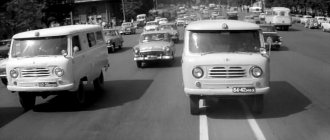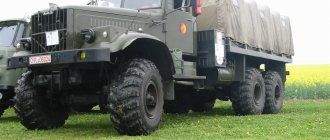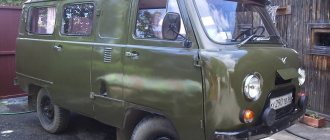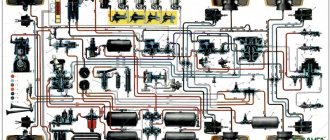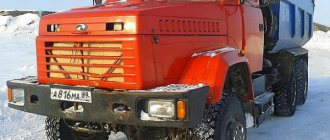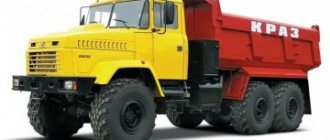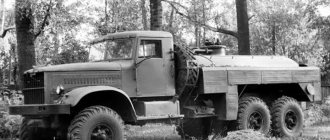From the very beginning of design and manufacturing, the KrAZ was positioned as a truck transporting heavy and bulky cargo. The main place of use of this car was to be Siberia and the Far East. In the spring of 1959, the plant assembled the first car, which was called “Dnepr 222”, and only over time this name was replaced by the well-known “KrAZ”. In a further review of this truck, it will be possible to consider the technical data of the vehicle - what is its secret of longevity, its advantages. It will also be possible to briefly familiarize yourself with the history of its production, various modifications and versions for military and civilian use.
General information about the car
The KrAZ is a heavy all-terrain vehicle on a 6x6 wheel base, at one time nicknamed the “Lunokhod” and “Lapotnik” because of its appearance. It was produced at the Kremenchug Automobile Plant from 1967 to 1894. The car was created on the basis of the KrAZ 214B, from which the appearance and general characteristics were taken, which is confirmed by the diagram of the KrAZ 255. The only difference between the new type of vehicle was the installation of a more powerful and economical engine, which began to consume half as much fuel, as well as wide-profile tires with the possibility of centralized pressure regulation air in them. The car was intended for transporting goods and transporting people, primarily military personnel, along ordinary roads and along mud roads. Its platform is all-metal, with a folding rear side and removable side additional sides.
About the inscriptions and drawings on the box
Here’s the bad luck, the new products from “Our Avtoprom” have got their names mixed up: the models and their boxes were mixed up at the packaging stage, which is why the box with “255B1” says “255B” and vice versa.
The drawings on the back of the box, which are so popular to discuss, actually quite accurately illustrate the work already done. Most of what is depicted has already been embodied in metal, the rest is being worked on or models are being released. There are no “castles in the air”...
KrAZ 255: technical characteristics
The truck has a three-seater cab, its frame is sheathed in metal and wood. Thanks to this design feature, the car is often called “the last of the wooden ones.” The car has an eight-cylinder diesel engine. Engine power is 240 hp. s, its volume is about 15 liters. The car has a double-disc clutch and a five-speed gearbox.
The KrAZ 255 vehicle has three axles, and all of them are driven with standardized main parts, with a two-stage gearbox and balanced axle shafts. The front axle is responsible for transmitting torque to the front wheels when turning. The middle axle is an intermediate one on which the driveshaft of the rear axle rests.
The truck's suspension consists of two parts: front and rear. The front has two longitudinal springs and the same number of hydraulic double-sided shock absorbers. The rear suspension contains two axle springs and six reaction bars.
The steering system has a piston-type hydraulic booster mechanism. The KrAZ 255 vehicle is equipped with drum brakes and a pneumatic drive to them, as well as additional engine and parking brakes with mechanical control.
Device
Externally, the KrAZ-255 looks rather unpretentious. The wooden cabin, which seats three, is lined with steel and is located behind the engine. The instrument panel is simplified as much as possible and has a small number of primitive indicators and mechanisms. In 1969, the appearance of the truck changed somewhat. The front part received a new lighting system mounted in a single rectangular body. Also in the cabin were windshield washers, an updated seat with a spring suspension, a set of additional settings and a hydraulic shock absorber, a panoramic glass heater, a removable sleeping bed and a heating system. The driver's seat became sprung and was adjusted for height and weight.
The body of the KrAZ-255 is made in the form of a metal cargo platform with a lattice side that opens at the rear, arches, side folding seats and an awning.
The convenience of controlling the tractor is added by the gearbox levers, axle differential, winch mechanism and hand brake installed in the cab.
During the design process, special attention was paid to ease of operation and ease of control of the vehicle. Initially, the tractor was equipped with a pneumatic power steering, which was soon replaced by hydraulics. The steering gear is characterized by a gear ratio of 23.6.
The advantages of the KrAZ-255 lie not only in its comfortable interior. The six-by-six road formula provides for the presence of three drive axles at once, which makes the model super-passable.
The truck received an advanced YaMZ-236N transmission for that period with a 2-disc dry friction clutch. The 2-speed manual transfer case was equipped with a center differential for the rear and middle axles.
The KrAZ-255 cardan transmission includes 5 open-type cardan shafts and an intermediate post. Each bridge is designed for specific nodes and is a master.
The updated front suspension is equipped with a pair of telescopic 2-way hydraulic shock absorbers and axial semi-elliptic springs. The rear suspension is located on 6 reactive metal rods and 2 axial semi-elliptic springs.
The KrAZ-255 is equipped with drum brakes with a 2-circuit pneumatic transmission. Unclamping occurs through a cam device. The parking brake is a drum-transmission device with a mechanical transmission.
The unusually long life of the car is due to the high quality of parts and successful design. The production of KrAZ-255 was suspended for personal reasons at the Kremenchug plant in 1993. At the same time, there were quite a lot of orders for the model at that time.
Price of new and used KrAZ 255
It will not be possible to buy a new KrAZ-255 vehicle, since the model has been discontinued. Options from 1990-1993 will cost 600-700 thousand rubles. Renting a KrAZ-255 is quite difficult. At the same time, the rental cost is 1000-1100 rubles per hour.
Installed equipment
The KrAZ 255, the photo of which is at the top, is presented in the usual configuration. But this car was also equipped with additional equipment and devices, which allowed it to serve not only in the military sphere, but also in the civilian sphere.
Auxiliary devices:
— pre-start engine heating device;
— tire air pressure control system (on models 255B and 255B);
— winch device (255B and 255L);
— equipment for timber transportation;
- coupling mechanism.
In 1979, a modernized version was launched into production - the KrAZ 255 B1, the technical characteristics of which had a slight difference from the base model - this type of truck had a separate brake drive.
Since the 70s, there has been a change in the external design of the car: headlights and direction indicators began to be installed in rectangular metal boxes. Until this time, they were located on KrAZ trucks in their streamlined bodies separately from each other.
Power point
The car was equipped with an 8-cylinder V-shaped diesel engine YaMZ-238 with a power of 240 hp. and a torque of 1765 N.m. It was paired with the YaMZ 236S gearbox, and later the YaMS 236. The use of a dry 2-disc clutch was a breakthrough for the automotive industry in the 60s of the last century. The transfer case is two-stage, mechanical. The PZD-44MBU pre-heater ensured engine starting at ambient temperatures down to minus 50 degrees.
Under the hood of KrAZ 255
Types of KrAZ 255 vehicle, characteristics and differences
The cars were produced in the following configurations:
- KrAZ 255B produced in 1967 is a basic modification of the car with or without a platform. Intended for transporting cargo and towing trailers on highways, dirt roads and off-road. On the chassis of this truck, some enterprises produce truck cranes, excavators, drilling rigs, mechanisms for driving piles and many other types of vehicles.
- KrAZ 255B1 is a type of vehicle that has a separate brake drive.
- KrAZ 255V is a tractor that towed 18-ton semi-trailers on ordinary and dirt roads and 26-ton semi-trailers on highways. In order to attach a semi-trailer, the car was equipped with a special coupling mechanism.
- KrAZ 255D is a vehicle designed for coupling with an MMZ 881 trailer.
- KrAZ 255L is a modification for transporting construction timber on a TMZ trailer.
Military and civilian modifications
For a long time, the KrAZ was the basic vehicle for transporting goods and personnel in the USSR army. But even now this vehicle is in service with the Russian army and army units of other countries. In addition, the KrAZ 255, model “B”, served as the basis on which other types of military and civilian equipment with the following devices were created:
— PMP pontoon park;
— heavy mechanized bridge TMM-3;
— excavator E-305BV;
— hydraulic excavator EOM;
— tanker truck.
The vehicle was and is now used in the civilian industry in the form of timber trucks and tractors, which can often be seen at the airfield and in some vehicle fleet. KrAZ 255 is also used in the oil and gas industry.
About the work done
Despite all the technological and budgetary limitations, overall the model turned out well. We managed to implement almost everything planned. As one of its authors, I sincerely believe that the overall level turned out to be higher than that of the previous and very successful development of the MAZ “500” family. The correctly shaped cabin became a good basis for the development of the remaining models of the family, both all-wheel drive and with a 6x4 wheel arrangement, the development of which has already been completed and the models have gone into production. For handy car modellers, the new product provides an opportunity to bring its detailing to the level of premium models with little effort. High overall accuracy will allow you not to waste time on correcting errors in geometry, but to devote all your efforts to detailing. The release of etching kits and decals that make this job easier is just around the corner. The affordable price will please fans of conversions and special equipment, since the KrAZ-255 as a prototype is extremely beneficial for this: the EOV-4421 excavator alone is worth it! And if we also aim at a pontoon park and other army special vehicles, then not a single shelf will withstand such a model line.
What do we have in the bottom line? Today, the two early models of the KrAZ-255 are clearly inferior to the new product of “Our Avtoprom” in terms of contour accuracy, which is visible to the naked eye. And another, so far only announced model, if it comes out, it will most likely have a cabin from the produced KrAZ-256 and -257, which has noticeable and difficult to eliminate errors in geometry. All this makes the KrAZ-255 from NAP the most accurate KrAZ model in the foreseeable future.
Applications of the car in the armed forces
Nowadays, “lapotnik” is widely used in almost all spheres of human life. But first of all, it was created as a military vehicle for use in the army.
The peculiarity of this military vehicle of the 255 series was that combat systems and weapons were not installed on its chassis. It was most often used in the army engineering service. Nowadays, it is also used in the army and is an indispensable assistant in solving certain combat missions. For example, the KrAZ type with the installation of a PMP pontoon bridge at the end of the last century was considered the best engineering solution in the world for crossing water bodies. It is still used in the armed forces of many countries, including the Russian army.
Very successful modifications of this type of vehicle are the TMM mechanical bridge and the EOV military excavator, which are still used by army specialists of the CIS countries and paramilitary UN peacekeeping units.
A lot of special equipment based on KrAZ was created for the development of airfields: fuel tankers, fire truck cranes, tractors, and so on. This special equipment can still be found at airports in our country and the CIS.
In the air defense forces, the dimensions of the KrAZ 255 were well suited for radar rangefinders and loading vehicles carrying ammunition for missile systems.
About technological concessions
The first 3D models received from Chinese developers were puzzling: the cabin turned out to be disproportionately narrow, the other proportions, although not ideal, were close to the truth. Subsequently, it turned out that the developers of the original mathematical model fell for the apparent external similarity of the KrAZ trucks with their Yaroslavl ancestors. Because of this, the cabin width was taken close to that of the YaAZ-210, which in the original was almost 300 mm smaller. After correcting this defect, the main dimensions of the model returned to normal and did not change significantly further.
Another initial mistake by the developers was the incorrect tire width, which appeared due to confusion with the narrower tires of the “214” family. After normalizing the basic dimensions, all further editing was carried out in the direction of clarifying the shape from photographs. Drawings of the KrAZ-255 in the version of an excavator and pontoon transport were previously published in model periodicals and used in the development of the model. The drawings were approached critically, clarifying controversial points from photographs, as a result of which the shape of the cabin and especially the roof came out more accurate than in the mentioned drawings. In general, the roof turned out to be the most difficult place in the cabin; it took the longest to finish. But as a result, the cabin of the NAP model turned out to be the most accurate in shape among other models, surpassing even the prefabricated model on a scale of 1:35.
As a stand tester, I often have to deal with an annoying situation when, due to the impossibility of removing the casting from the mold when casting an imitation of an entire model assembly into one part, I had to refuse to reproduce some of the features of the shape or texture inherent in the prototype. And if in the manufacture of a prefabricated model this problem would often be solved by dividing the part into several parts, then this option was not suitable for the finished 43rd scale model. In principle, this problem can only be overcome by casting resin into soft molds, but this is completely unsuitable for mass industrial production.
After editing the model in several stages, only a couple of minor inaccuracies leaked into the final configuration. I personally missed one mistake as a consultant. I noticed that the upper signal pipe was a bit short relative to the lower one already when it was too late to correct it, and this could only be corrected on 6x4 models. The second mistake was made directly by Chinese manufacturers: the 3D model approved for release had a relief on the sidewalls of the tires, which, unfortunately, was not embodied in the finished model due to technological problems.
Regarding the much-discussed absence of mustache markers, I hasten to assure you: this is not a mistake, but a completely conscious choice of the authors of the project. Realizing full well that it would not be possible to make these details gracefully, and that instead of large-scale thin parts, we didn’t want to have two clubs sticking out of the wing, we simply abandoned the poor imitation. This option was considered acceptable - during operation, many cars quickly lost their dimensional indicators. For the same reasons, they did not imitate the seams of the sheet metal joints on the cabin doors. Given the available technological capabilities, it would have turned out to be crude and exaggerated on a small scale.
In comparison with the MAZ models, it was possible to more successfully place the attachment points of the model to the stand; the mounting points almost never pass through the parts of the model; only the axis of the balancing trolley was damaged. A new feature in the model is the material of the rear-view mirrors. The plastic from which the model is made is very soft, almost rubber-like; the opinions of model owners on this issue are divided - some prefer the old, harder plastic. However, other collectors, and even more so model sellers, on the contrary, are delighted with this decision, since there are practically no broken mirrors. Probably, in this case, the practicality of such a solution wins out.
Conquest of deserts and tropics by “lunar rover”
Our “lunar rover” has a very impressive career abroad. During their mass production, these cars were exported to 50 countries. They traveled on roads all over the world, except Australia and Antarctica. You can often see our KrAZ 255, photos of which are posted on foreign websites and magazines. True, the color scheme of the car has been changed to suit the characteristics of the areas in which it is used.
In addition to the main positive characteristics of our truck, foreign buyers also like it for its durability. After all, a lot of time has passed since its production ceased, and these cars can be found on the roads not only of our country, but also where they were once exported.
On the European continent, KrAZ is most often found in the territories of Poland and Germany. After these countries joined NATO, cars began to be withdrawn from use by the military. Thus, they fell into private hands and are used as tow trucks and tourist vehicles transporting tourists over difficult terrain. KrAZ trucks in Europe become participants in auto shows and even take part in wedding convoys.
The trace of the car in the history of our state
Over the years of production of the KrAZ 255, the automobile plant in Kremenchug produced about 82,000 of their varieties and types. The most productive year for truck production was 1981. This year, more than 5.5 thousand vehicles were produced for the needs of the USSR and foreign countries.
The total number of KrAZ trucks produced by the Kremenchug plant is more than 197 thousand vehicles.
After the collapse of the USSR, the car was produced for another two years, but at the end of 1993 - at the beginning of 1994 it was discontinued and more modern and economical models of off-road vehicles began to be produced.
An interesting episode involving KrAZ 255B
In order for the reader to understand the power and reliability of this car, it is enough to cite as an example one well-known case, which at one time received publicity even in the media.
In the summer of 2006, a strange KrAZ 255B appeared on the roads of Ukraine, the owners of which were a married couple from Germany. They were on a tourist trip along the Black Sea coast and stopped in Kremenchug.
What is surprising is that this car was produced back in 1972 and worked in Germany all this time. In 2006, it was bought by Rainer, the current owner of KrAZ, for 15,000 euros and converted into a mobile camper with all the amenities. But the engine itself, the main components and assemblies, as well as the wheels remained the same as they were installed during its production.
The owners of the car drove thousands of kilometers to get to the city of Kremenchug and finally change the tires that had not been changed since 1978!
When asked by journalists why he bought such an “old man” instead of modern SUVs, Rainer replied that the KrAZ, compared to modern cars, is much more reliable, since the electronics of the latest SUVs constantly fail. And for a Soviet truck, all that is needed for repair is a key and half an hour of time!
Rainer is confident that his car will serve him for another half a century. He also notes that the current automotive industry, with all its innovations, cannot be compared in terms of reliability with his KrAZ.
Will Ukraine produce MANs? KrAZ trucks with cabs like MANs!
“Now Ukraine will produce MANs?” - readers will be surprised. Not MANs, but KrAZ trucks with cabs like MANs! Moreover, these cabins were made in China...
A person is greeted by his clothes, and a truck is greeted by his cabin! It is not surprising that the headache of truck manufacturers in the CIS is the cab. MAZ was lucky: back in the nineties they developed their own and very spacious “new model” cabin. GAZ is now relying on the cabin from the Gazelle Next: it will be installed on “lawns” and even on Urals. KAMAZ began purchasing cabs from Mesedes and promises that from 2016 it will produce its own new cabs, developed together with the Koreans.
And the Ukrainian KrAZ... There, a few years ago, they realized that a traditional hooded cab - be it with an iron or a new fiberglass nose - would not allow expanding the range of vehicles. Meanwhile, the strength of KrAZ lies precisely in the flexibility of the production program: since the volumes are small (about 300 vehicles were made in the first half of this year, about 200 copies were made in July and August), it means that it is necessary to take a variety of designs.
Therefore, in 2009, we created our own cabover cab with fiberglass panels on a metal frame. It was installed on a number of models, from a dump truck to a fire truck, but now, according to Krasovites, the design is once again undergoing revision. According to unofficial information, it turned out to be too expensive.
In 2009, KrAZ created its own fiberglass cab
...and in 2011 he adapted the Renault cabin. The picture shows a “cleaner” with a Mercedes gas engine
0 / 0
But the “branded” purchased Renault Kerax cabin, which was originally planned to be equipped with municipal vehicles, has taken root on other versions: for example, there are such timber trucks, dump trucks, and grain trucks. The latest novelty is a “cleaner” with a Mercedes engine, a gas one at that, and Turkish Katmerciler equipment.
But a European-made cabin is still not cheap, and therefore the plant has found new partners. Where? That's right, in China, where KrAZ has been receiving Shaanxi Fast Gear gearboxes for a long time. Even before creating their own cabin, Krazov built an experimental dump truck with a Shaanxi cabin (licensed cabin from the old MAN F2000 model), and a couple of years ago, at the Comtrans exhibition, they showed a chassis with such a cabin.
But the newest KrAZ-6511 for an agricultural road train has a different cabin - the same as the MAN, only a later one, the TGA model. But Shaanxi doesn’t produce such a cabin! In addition, if you look closely, you can see that the doors are clearly not “Manov”, and the interior is not at all similar.
The interior of the Qixing cabin is made “in the spirit of the Mercedes Actros tractor”
Large windows in the back wall are clearly unnecessary: they will draw in the cold!
0 / 0
Our investigation showed that the cabin was made at the Chinese factory Qixing, which, according to information on the Internet, produces 100 thousand cabins of 180 items a year. All of them, of course, are unlicensed: whatever design the client wants, that’s what they will do! “Like a Mercedes”, “like a Scania”, “like a MAN”... And the client also attaches the emblem he wants.
So the cabin that is installed on the KrAZ-6511 is a Qixing model PW21: the Chinese Youngman and the Iranian company AMICO install the same cabins on their vehicles. And the “Mercedes style” interior is exactly like the Russian Tonar trucks: after all, Tonar also buys cabs from Qixing! The Krazovites themselves are happy with the cabin: according to them, it is several times cheaper than a Renault cabin, and at the same time it has all the necessary elements of comfort - air conditioning, curtains, radio.
“Laptezhnik” KrAZ-V12.2MEH named Sergeant is a promising military all-terrain vehicle with a Shaanxi cabin (former MAN F2000 cabin) and a 385-horsepower Cummins ISMe engine
The power unit is also Chinese: a 400-horsepower Weichai engine (it meets Euro 4 standards thanks to urea neutralization), the gearbox is a 12-speed Shaanxi Fast Gear.
So this grain truck with a trailer will clearly be cheaper than last year’s predecessor, a grain truck with a Renault cab, a YaMZ engine and a ZF gearbox! In any case, the road train has already been shown at the Sorochinsky fair and will soon go for testing.
The Qixing plant offers a cabin “like the MAN TGA” to everyone: buy it and install any emblem! The same cabin, only with a different design, is received by the Chinese Hongyan. And here is the same cabin, only with a “Mercedes” cladding and the emblem of the Chinese manufacturer Tiema
And the Krasovites adapted the licensed Shaanxi cabin for promising military all-terrain vehicles called Sergeant: they are planning to release a six-ton 4x4 model and a 12-ton 6x6 model. It is curious that in the indices of these KrAZs there are large letters “MEX”, but neither mechanics nor Mexico have anything to do with it: “M” is a “MAN cab”, “E” is all-wheel drive, “X” is with a single-pitch tire. Here the engines are already branded Cummins (but, apparently, also made in China), the gearboxes are the same Shaanxi Fast Gear. The officially declared reference fuel consumption of both versions is 39 l/100 km.
But the Sergeant still has his own appearance, but how will MAN representatives react to the fact that the civilian KrAZ with a Qixing cab looks like a MAN TGA? I remember that at one time the Germans refused to supply KAMAZ with a TGA cab precisely because the cars would be too similar. And the KrAZ-6511 is not just similar - it’s a twin brother, only with a different inscription on the front! That’s for sure - “UkrMAN”. In the sense of “stolen,” although the Ukrainians had nothing to do with it.
The Iranian company AMICO installs the “Manov” Qixing cabin on their cars...
...and Chinese Youngman. I really want to look “like a real MAN”!
0 / 0
Results of the KrA3 review
Based on all of the above, we can summarize: the KrAZ 255 vehicle is the most successful and massive project not only of the Kremenchug plant, but also of the entire Soviet automobile industry. It was thanks to these cars that the fame of Kremenchug as a powerful automotive center spread throughout the Union and beyond. These machines continue to be used in countries such as India, Vietnam, Ethiopia, Angola, Chile and many others. Because of their reliability and durability, these cars gained respect almost everywhere they were used.
